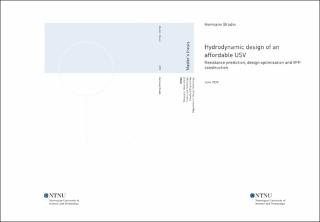| dc.contributor.advisor | Savio, Luca | |
| dc.contributor.advisor | Echtermeyer, Andreas | |
| dc.contributor.author | Brodin, Hermann | |
| dc.date.accessioned | 2021-09-21T16:36:12Z | |
| dc.date.available | 2021-09-21T16:36:12Z | |
| dc.date.issued | 2020 | |
| dc.identifier | no.ntnu:inspera:54166542:20964128 | |
| dc.identifier.uri | https://hdl.handle.net/11250/2780171 | |
| dc.description.abstract | Denne masteroppgaven presenter et arbeid som er gjennomført for å designe et rimelig priset ubemannet overflatefartøy. Oppgaven er delt inn i fire steg hvorav den første er å kombinere potensialteori, empiriske modeller og en regresjonsformel til en samlet motstandsmodell for å predikere motstanden til fartøyet. Det neste steget bruker motstandsmodellen til å gjennomføre en partikkelsvermeroptimalisering, for å minimere motstanden til fartøyet. Det tredje steget innebærer simuleringer med numerisk fluiddynamikk for å finne lastene som virker på fartøyet i konstant rull, stamp og gir. I det fjerde steget er lastene fra simuleringene brukt til å lage et hastighet prediksjonsprogram.
Bølgemotstandsmodellene i første steg er Michells tynt skip teori i kombinasjon med en regresjonsfunksjon for torpedoen. Den viskøse motstanden er predikert med ITTC 57' linjen og formfaktorene foreslått av MARINTEK og Hoerner. Det er observert store forskjeller mellom motstanden predikert av motstandsmodellene og resultatene fra simuleringene. Det er antatt at den største kilden til avvik kommer av at deformasjonen av den frie overflaten ikke blir tatt hensyn til av motstandsmodellene.
I steg to er optimeringen gjennomført seks ganger med en hastighet på 3m/s, de fem optimeringene som endte med lavest motstand er alle innenfor intervallet 132N-134N. De to optimeringsparameterene med nevneverdig forskjell blant geometriene er størrelsen på torpedoen og høyden på kjølen. De resterende fem optimeringsparameterene er tilnærmet lik for alle geometriene.
I det tredje steget er den beste geometrien fra optimeringen simulert med en hastighet på 3m/s i åtte forskjellige orienteringer; to i rull, to i stamp, tre i gir og en rett frem. I tillegg er tre simuleringer i stamp gjennomført med null hastighet for å skille de dynamiske og statiske kreftene.
I det fjerde steget lastene fra simuleringene gjort dimmensjonsløse ved hjelp av koeffisienter. Disse koeffisientene blir brukt av hastighets prediksjonsprogrammet for å predikere hastigheten til fartøyet ved en gitt hastighet og orientering. Ved en spesifisert vindhastighet of vindretning blir orienteringen og hastigheten til båten iterert helt til en likevekt mellom seilkreftene og de hydrodynamiske kreftene er oppnådd.
Ifølge hastighets prediksjonsprogrammet er fartøyet i stand til å oppnå en hastighet på 2.5m/s med en sidevind på 9m/s, som er vindhastigheten ved 50% prosentilet i Nordsjøen. Hastigheten til fartøyet i dette studiet oppnår sammenlignbar hastighet som SailDrone prosjektet og er noe raskere enn det mindre fartøyet Sailbuoy.
Fartøyet har gode egenskaper for å motstå moment i rull, men har forbedringspotensialet i stamp og gir siden det er nesten like bredt som langt. | |
| dc.description.abstract | This report presents a study on the design of an affordable USV having 200kg displacement, and the investigation consist of four stages. The first stage is the development of a solver to predict the resistance of the vessel based on potential theory, empirical models, and a regression formula. Secondly, a particle swarm optimisation is carried out with respect to resistance. The third part involves CFD simulations of the vessel in various roll, trim, and yaw angles to obtain hydrodynamic load coefficients. Finally, a VPP is constructed based on the coefficients from CFD.
The resistance models for wave resistance in the first part is Michell's thin ship theory in combination with a regression formula for the wave resistance of a torpedo. The viscous resistance is predicted by the ITTC' 57 line and form factors proposed by MARINTEK and Hoerner. Large discrepancies between the resistance models and the CFD-results are observed, and the reason is expected to come from the deformation of the free surface not being accounted for by the resistance models.
In the second part is the optimisation of the geometry carried out six times at the vessel velocity 3m/s, and the five outputs with the lowest resistance are all in the interval from 132N to 134N. The two optimisation parameters with considerable variations are the torpedo size and the height of the keel, and the remaining five parameters are close to equal for all of the geometries.
In the third part is the best geometry obtained from the optimisation simulated in eight different orientations at 3m/s; two in roll, two in trim, three in yaw and one with no rotation. Additional three simulations are conducted in trim with zero vessel velocity to separate the static and dynamic loads.
In the fourth part is the loads from CFD made dimensionless by a set of coefficients. These coefficients are used to predict the hydrodynamic loads on the vessel at a given orientation and a given velocity by the VPP. For a specific wind speed and direction is the orientation and velocity of the vessel iterated until an equilibrium between sail loads and hydrodynamic loads are obtained.
According to the VPP is the vessel able to obtain a velocity of 2.5m/s if the vessel is beam reaching in 9m/s wind speed, which is the 50% percentile of the wind speed in the North sea. The VPP predict a velocity of the current vessel comparable to the successful SailDrone project, and somewhat faster than the smaller Sailbuoy.
The vessel is capable of resisting large roll moments but has possibilities for improvement in trim and yaw due to the length-to-breadth ratio being close to unity. | |
| dc.language | | |
| dc.publisher | NTNU | |
| dc.title | Hydrodynamic design of an affordable USV | |
| dc.type | Master thesis | |
